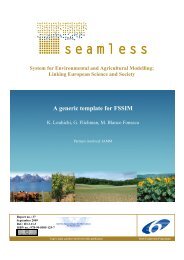Farming Systems Design 2007 - International Environmental ...
Farming Systems Design 2007 - International Environmental ...
Farming Systems Design 2007 - International Environmental ...
Create successful ePaper yourself
Turn your PDF publications into a flip-book with our unique Google optimized e-Paper software.
<strong>Farming</strong> <strong>Systems</strong> <strong>Design</strong> <strong>2007</strong><br />
Field-farm scale design and improvement<br />
efficiency of the energy chain (from solar energy to mechanical energy). While PV reaches 4.9%,<br />
hydrogen attains 0.9 % and ethanol 0.04 % only. This values correspond to 43.5 toe/ha for PV, 8.3<br />
toe/ha for hydrogen and 0.38 toe for ethanol respectively.<br />
If we consider oil from rapeseed instead of ethanol from wheat, we can analyse that i) the energy<br />
balance is better (only 0.33 MJ of non renewable energy for 1 MJ delivered energy), ii) the yield<br />
per ha is lower (1370 litres of oil for 3.3 t grain instead of 2550 litres of ethanol for 9 t grain), iii) the<br />
energetic content is higher (37.2 MJ/kg instead of 26.8) (ADEME 2002 and 2006). Finally, the<br />
renewable energy produced is not better with 34.1 GJ/ha vs 34.8 for ethanol.<br />
<br />
<br />
<br />
<br />
<br />
<br />
! ! "<br />
# $ <br />
%& ' (<br />
<br />
This study may appear very theoretically hence the presented technologies are subject of<br />
continuous development. However, the aim is to show the gap between bio fuel from energy crops<br />
and PV fuel. Such large differences of efficiencies show clearly where to set priorities for the long<br />
term research. Research on solar-technical processes to produce thermo chemical fuels (Abu-<br />
Hamed et al. <strong>2007</strong>) or liquid carbon hydrates from methane, carbon dioxide and water powered by<br />
solar energy without diversion into photosynthesis (Gattrell et al. <strong>2007</strong>, Centi & Perathoner 2006)<br />
offers much a greater potential than research on energy crop production.<br />
Setting the priority for one or the other of these two pathways may have a strong impact either on<br />
economics or on environmental issues, or even on food resources and social aspects. For<br />
example, production of PV energy needs only 1 % of the area provided for energy crops and the<br />
saved 99 % of the area compensate more than the lower yield of organic farming area in terms of<br />
food quantity per ha. Organic farming plus PV energy production reduce not only energy<br />
consumption for food production but also reduce environmental pollution.<br />
Another advantage of PV energy is that it can be produced not only on the poorest arable lands<br />
but also on the roofs of the buildings, whether they are agricultural, industrial, or urban. Installation<br />
of solar panels in mountain areas improves the efficiency of PV because of lower temperature and<br />
reduces competition for better lands.<br />
Presently, the energy of one hour insolation reaching the earth would be enough to cover the<br />
annual energy consumption of the world. One challenge for research is to use solar energy as<br />
directly as possible with the minimum of transformations. Therefore, the direct technical use of sun<br />
energy allows i) to satisfy the food needs of the humanity, ii) to reduce inputs with strong negative<br />
impacts on the environment and on human health, iii) to reserve a part of arable land for the<br />
production of non alimentary agricultural products (fibres, drugs, feedstocks).<br />
The agricultural sector in Europe consumes more energy than it produces. The major part of<br />
biomass produced for feedstocks and food remains energetically unused. Organic waste is the<br />
right source for biofuel production hence it requires only energy for conversion and storage. We<br />
suppose that the progress based on research and development will not impugn these conclusions.<br />
<br />
<br />
Abu-Hamed T. et al <strong>2007</strong>: The use of boron for thermochemical storage and distribution of solar energy.<br />
Solar Energy 81 (<strong>2007</strong>) 93–101.<br />
ADEME 2006, Energy and GHG balances of biofuels and conventional fuels. Convergences and<br />
divergences of main studies, Study realized for ADEME by ECOBILAN, 18p.<br />
ADEME 2002, Bilans énergétiques et gaz à effet de serre des filières de production de biocarburants en<br />
France. Note de synthèse (décembre 2002). ADEME-DIREM-PRICE WATERHOUSECOOPERS, 19p.<br />
Centi G., Perathoner S. 2006: Converting CO2 to fuel: A dream or a challenge? The 232nd ACS National<br />
Meeting, San Francisco, CA, September 10-14, 2006,<br />
Elsayed M. et al 2003. Carbon and energy balances for a range of biofuels options. Project report number<br />
B/B6/00784/REP, Department of Trade and Industry Sustainable Energy Programme URN, 03/836,<br />
Resources Research Unit, Sheffield Hallam University, Un.Kingdom. Final Report for the Energy Technology<br />
Support Unit. Report No. 21/3, 27 S. http://www.dti.gov.uk/files/file14925.pdf?pubpdfdload=03%2F836<br />
Gattrell M. et al <strong>2007</strong>. Electrochemical reduction of CO2 to hydrocarbons to store renewable electrical<br />
energy and upgrade biogas. Energy Conversion and Management 48:1255–1265.<br />
<br />
- 38 -




